Abstract
Acute encephalopathy is a major cause of death and neurological handicap in children. The principle aims of treatment are to provide adequate cerebral blood flow for the brain's metabolic needs and to prevent intracranial pressure rising above the level at which brain herniation occurs. Rational management requires an understanding of the pathophysiological changes in cerebral blood flow and metabolism which occur. The paucity of data on this subject reflects the perceived difficulty of measuring cerebral blood flow and cerebral metabolism in children. A modification of the Kety Schmidt technique of measuring cerebral blood flow and cerebral metabolism is described. This modification makes it possible to perform serial bedside measurements in children receiving intensive care. This method was used to perform 348 measurements in 58 children. The method was reproducible and no significant complications were encountered. The results indicated that appreciable changes in cerebral blood flow and metabolism could occur in individual patients over time, emphasising the importance of serial measurements. This technique may provide a practical means of monitoring cerebral blood flow and metabolism in very sick children receiving neurointensive care and evaluating the efficacy of treatment.
Full text
PDF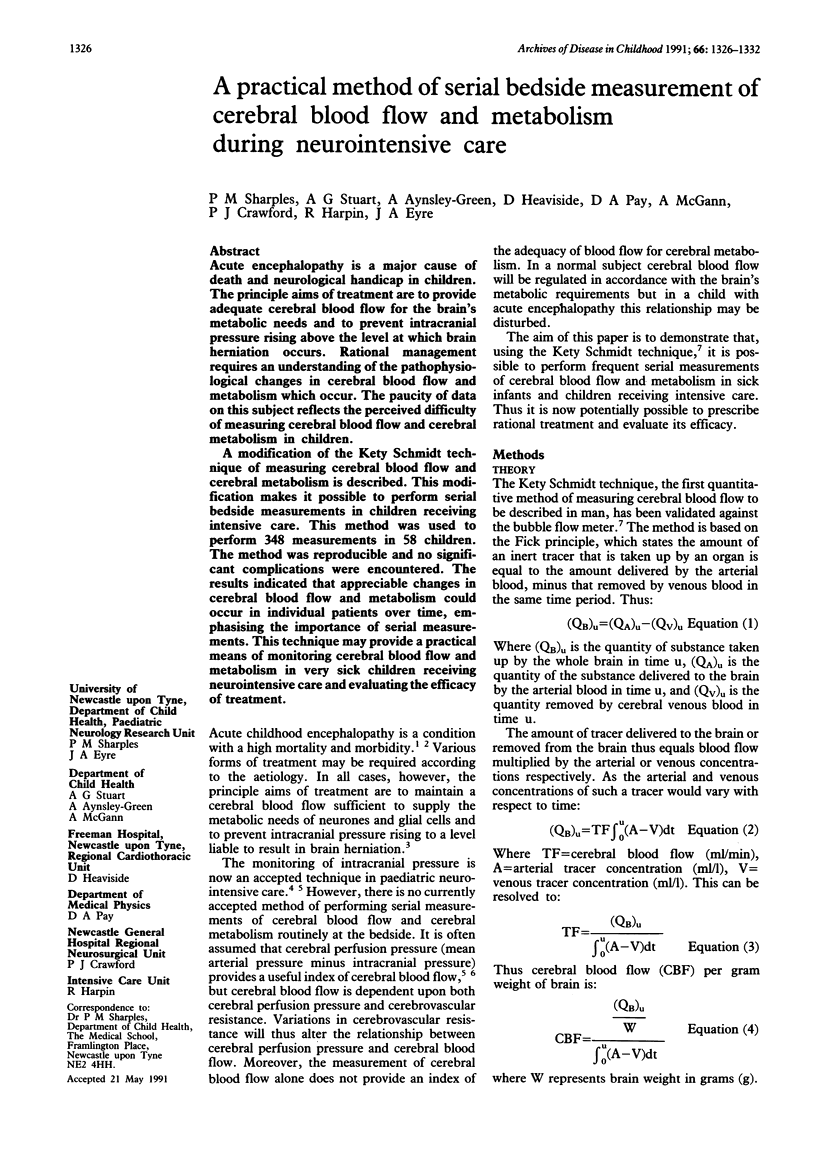
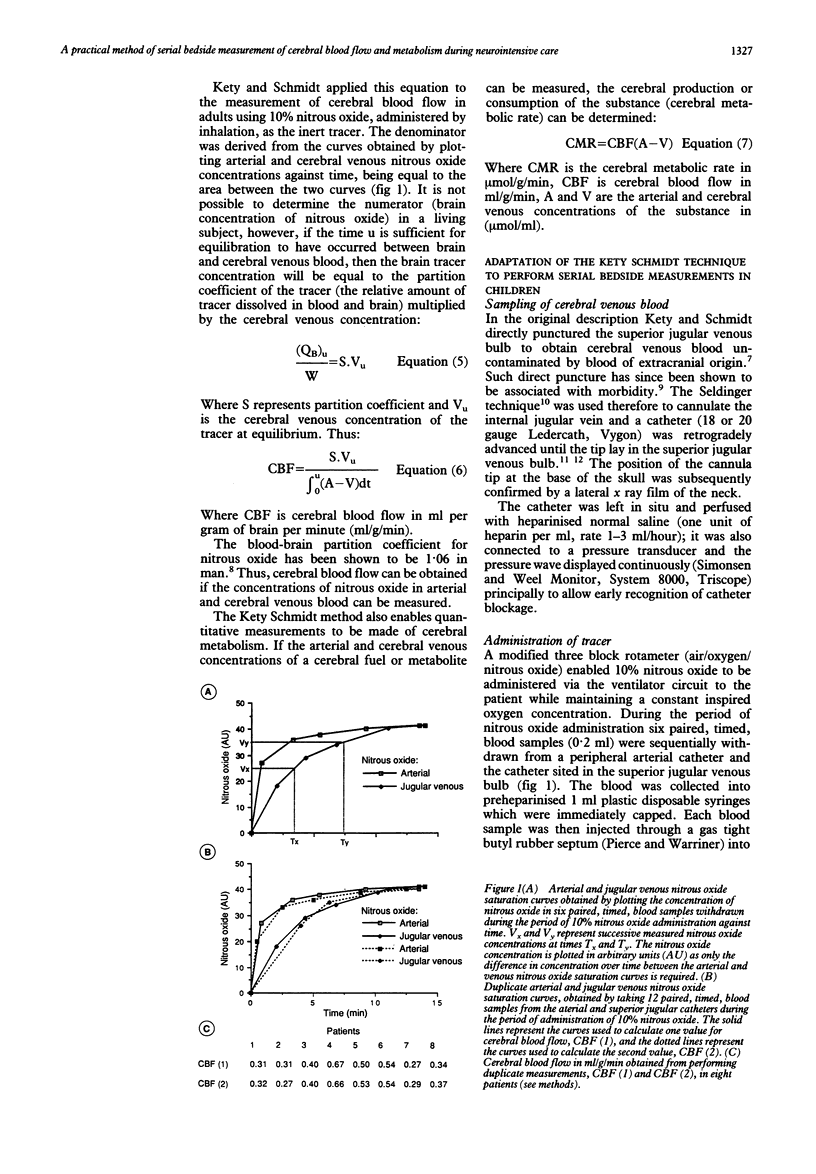
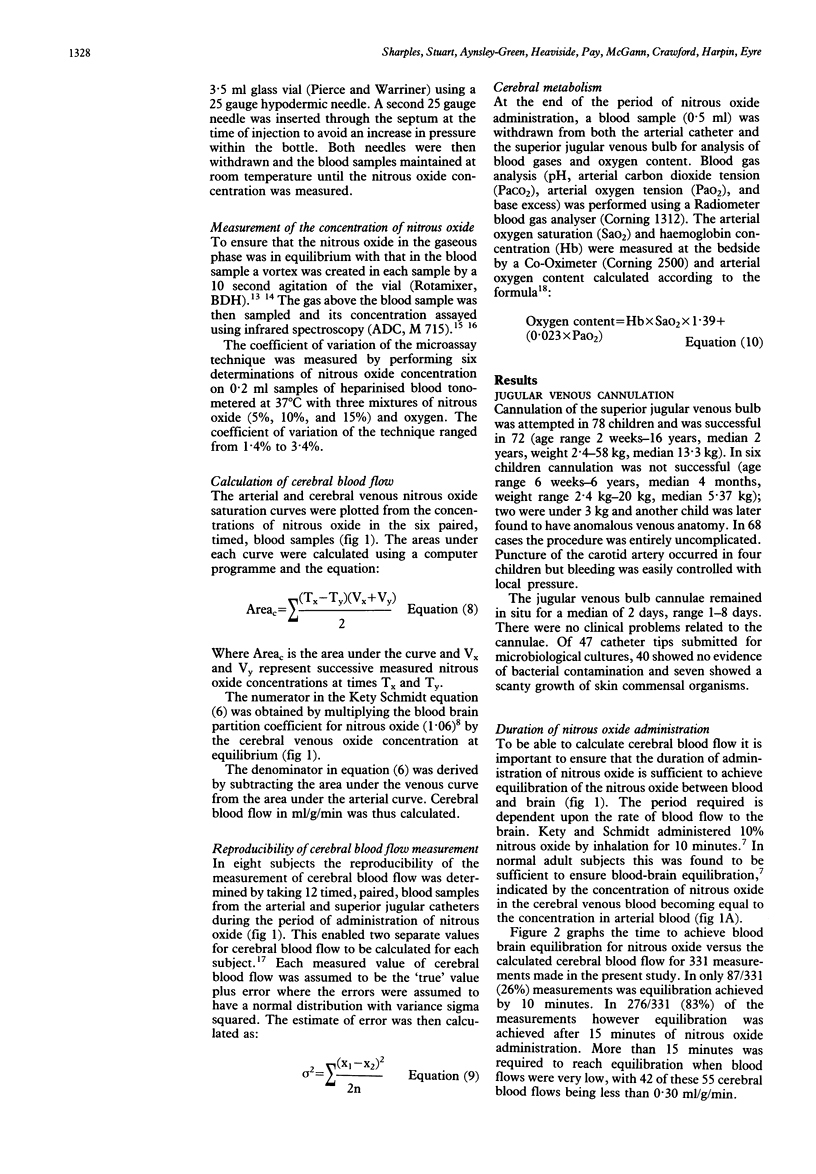
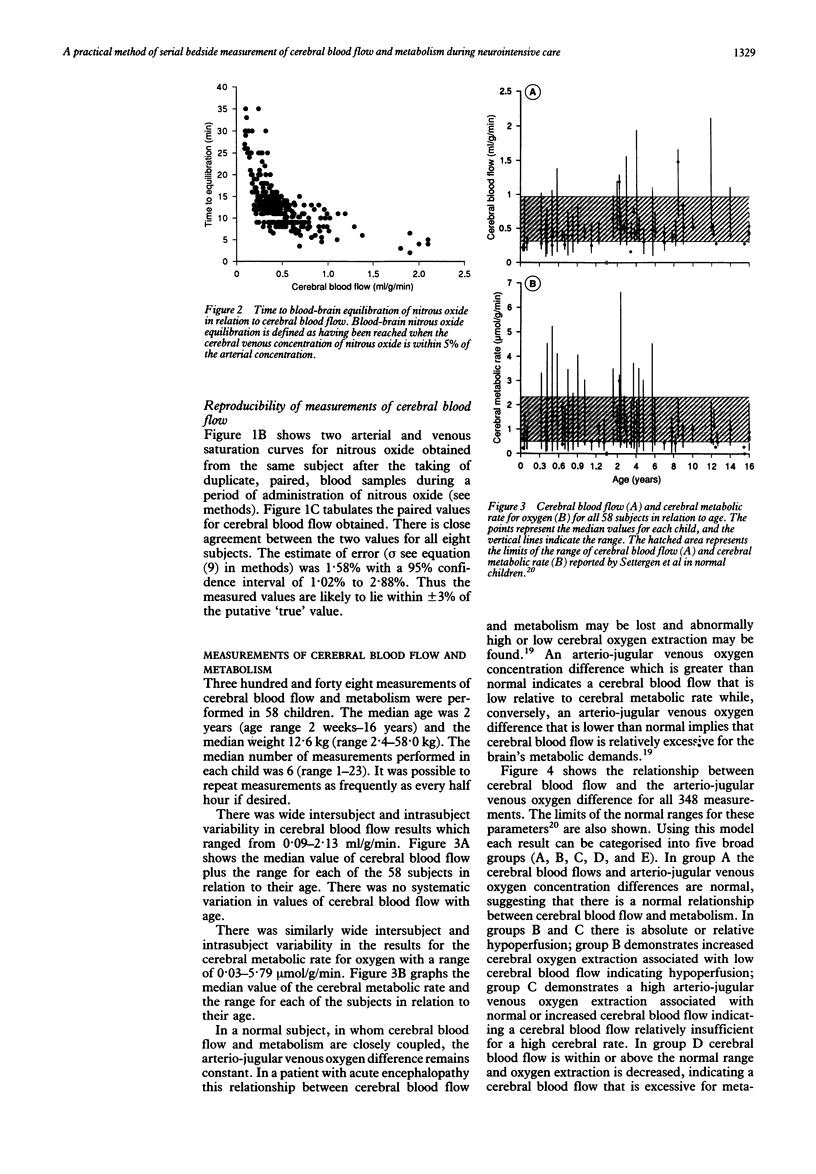
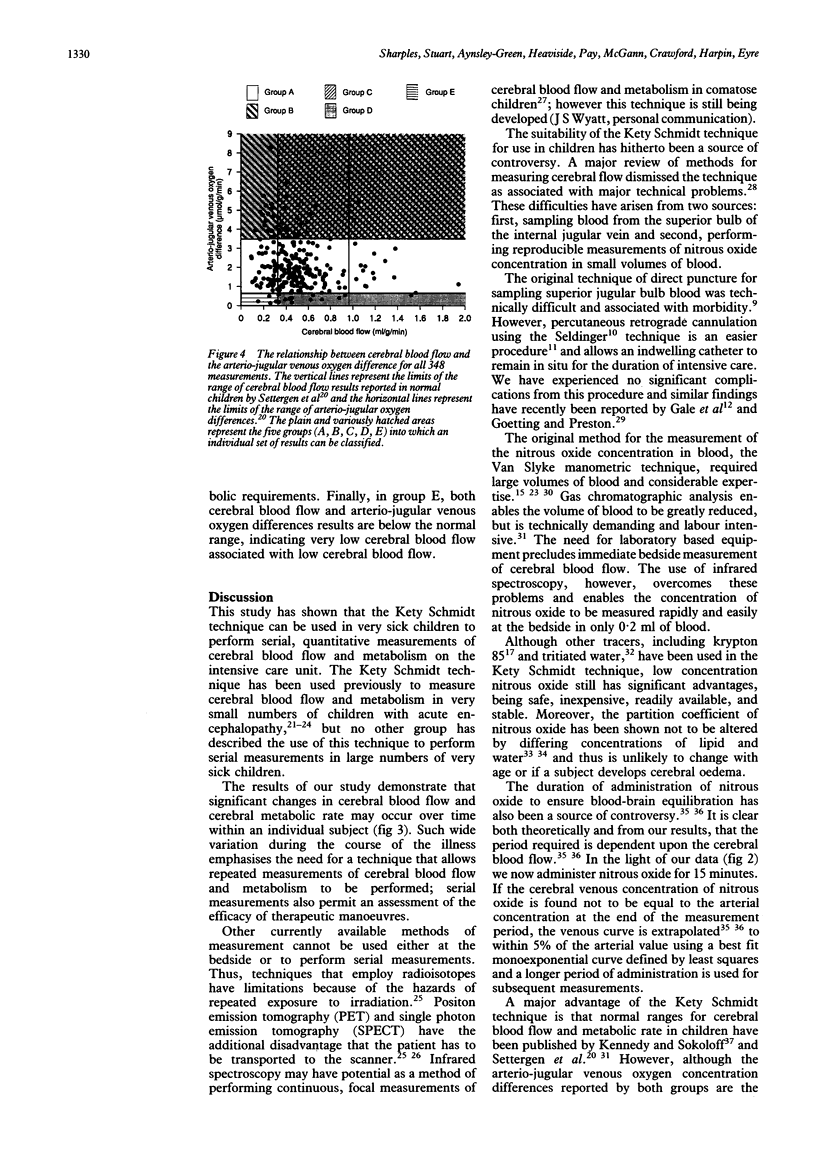
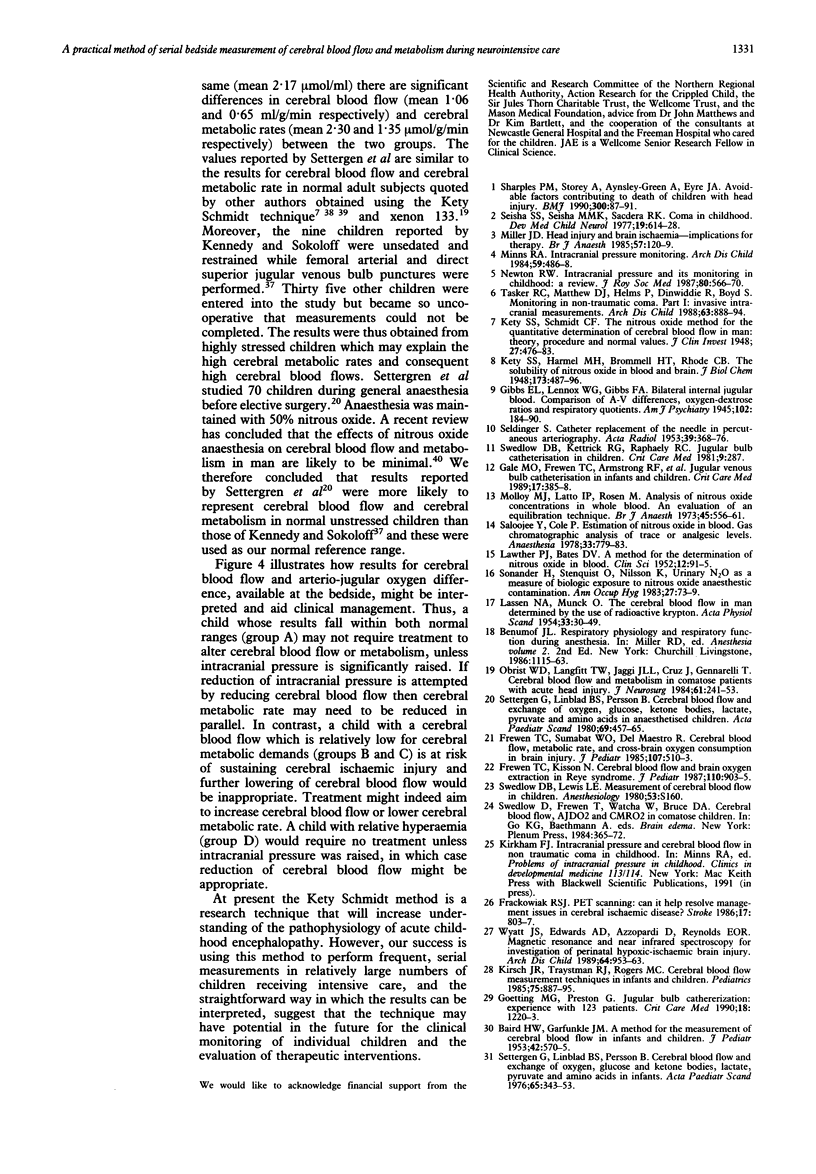

Selected References
These references are in PubMed. This may not be the complete list of references from this article.
- BAIRD H. W., 3rd, GARFUNKEL J. M. A method for the measurement of cerebral blood flow in infants and children. J Pediatr. 1953 May;42(5):570–575. doi: 10.1016/s0022-3476(53)80133-2. [DOI] [PubMed] [Google Scholar]
- Cohen P. J., Alexander S. C., Smith T. C., Reivich M., Wollman H. Effects of hypoxia and normocarbia on cerebral blood flow and metabolism in conscious man. J Appl Physiol. 1967 Aug;23(2):183–189. doi: 10.1152/jappl.1967.23.2.183. [DOI] [PubMed] [Google Scholar]
- Frackowiak R. S. PET scanning: can it help resolve management issues in cerebral ischemic disease? Stroke. 1986 Sep-Oct;17(5):803–807. doi: 10.1161/01.str.17.5.803. [DOI] [PubMed] [Google Scholar]
- Frewen T. C., Kissoon N. Cerebral blood flow and brain oxygen extraction in Reye syndrome. J Pediatr. 1987 Jun;110(6):903–905. doi: 10.1016/s0022-3476(87)80408-0. [DOI] [PubMed] [Google Scholar]
- Frewen T. C., Sumabat W. O., Del Maestro R. F. Cerebral blood flow, metabolic rate, and cross-brain oxygen consumption in brain injury. J Pediatr. 1985 Oct;107(4):510–513. doi: 10.1016/s0022-3476(85)80006-8. [DOI] [PubMed] [Google Scholar]
- Gayle M. O., Frewen T. C., Armstrong R. F., Gilbert J. J., Kronick J. B., Kissoon N., Lee R., Tiffin N., Brown T. Jugular venous bulb catheterization in infants and children. Crit Care Med. 1989 May;17(5):385–388. doi: 10.1097/00003246-198905000-00001. [DOI] [PubMed] [Google Scholar]
- Goetting M. G., Preston G. Jugular bulb catheterization: experience with 123 patients. Crit Care Med. 1990 Nov;18(11):1220–1223. doi: 10.1097/00003246-199011000-00006. [DOI] [PubMed] [Google Scholar]
- KENNEDY C., SOKOLOFF L. An adaptation of the nitrous oxide method to the study of the cerebral circulation in children; normal values for cerebral blood flow and cerebral metabolic rate in childhood. J Clin Invest. 1957 Jul;36(7):1130–1137. doi: 10.1172/JCI103509. [DOI] [PMC free article] [PubMed] [Google Scholar]
- Kety S. S., Schmidt C. F. THE NITROUS OXIDE METHOD FOR THE QUANTITATIVE DETERMINATION OF CEREBRAL BLOOD FLOW IN MAN: THEORY, PROCEDURE AND NORMAL VALUES. J Clin Invest. 1948 Jul;27(4):476–483. doi: 10.1172/JCI101994. [DOI] [PMC free article] [PubMed] [Google Scholar]
- Kirsch J. R., Traystman R. J., Rogers M. C. Cerebral blood flow measurement techniques in infants and children. Pediatrics. 1985 May;75(5):887–895. [PubMed] [Google Scholar]
- Kozam R. L., Landau S. M., Cubina J. M., Lukas D. S. Solubility of nitrous oxide in biologic fluid and myocardium. J Appl Physiol. 1970 Nov;29(5):593–597. doi: 10.1152/jappl.1970.29.5.593. [DOI] [PubMed] [Google Scholar]
- LASSEN N. A., KLEE A. CEREBRAL BLOOD FLOW DETERMINED BY SATURATION AND DESATURATION WITH KRYPTON-85: AN EVALUATION OF THE VALIDITY OF THE INERT GAS; METHOD OF KETY AND SCHMIDT. Circ Res. 1965 Jan;16:26–32. doi: 10.1161/01.res.16.1.26. [DOI] [PubMed] [Google Scholar]
- LASSEN N. A., MUNCK O. The cerebral blood flow in man determined by the use of radioactive krypton. Acta Physiol Scand. 1955 Feb 16;33(1):30–49. doi: 10.1111/j.1748-1716.1955.tb01191.x. [DOI] [PubMed] [Google Scholar]
- LAWTHER P. J., BATES D. V. A method for the determination of nitrous oxide in blood. Clin Sci. 1953 Feb;12(1):91–95. [PubMed] [Google Scholar]
- Mapleson W. W., Evans D. E., Flook V. The variability of partition coefficients for nitrous oxide and cyclopropane in the rabbit. Br J Anaesth. 1970 Dec;42(12):1033–1041. doi: 10.1093/bja/42.12.1033. [DOI] [PubMed] [Google Scholar]
- Miller J. D. Head injury and brain ischaemia--implications for therapy. Br J Anaesth. 1985 Jan;57(1):120–130. doi: 10.1093/bja/57.1.120. [DOI] [PubMed] [Google Scholar]
- Minns R. A. Intracranial pressure monitoring. Arch Dis Child. 1984 May;59(5):486–488. doi: 10.1136/adc.59.5.486. [DOI] [PMC free article] [PubMed] [Google Scholar]
- Molloy M. J., Latto I. P., Rosen M. Analysis of nitrous oxide concentrations in whole blood: an evaluation of an equilibration technique. Br J Anaesth. 1973 Jun;45(6):556–562. doi: 10.1093/bja/45.6.556. [DOI] [PubMed] [Google Scholar]
- Newton R. W. Intracranial pressure and its monitoring in childhood: a review. J R Soc Med. 1987 Sep;80(9):566–570. doi: 10.1177/014107688708000911. [DOI] [PMC free article] [PubMed] [Google Scholar]
- Obrist W. D., Langfitt T. W., Jaggi J. L., Cruz J., Gennarelli T. A. Cerebral blood flow and metabolism in comatose patients with acute head injury. Relationship to intracranial hypertension. J Neurosurg. 1984 Aug;61(2):241–253. doi: 10.3171/jns.1984.61.2.0241. [DOI] [PubMed] [Google Scholar]
- SELDINGER S. I. Catheter replacement of the needle in percutaneous arteriography; a new technique. Acta radiol. 1953 May;39(5):368–376. doi: 10.3109/00016925309136722. [DOI] [PubMed] [Google Scholar]
- Saloojee Y., Cole P. Estimation of nitrous oxide in blood. Gas chromatographic analysis of trace or analgesic levels. Anaesthesia. 1978 Oct;33(9):779–783. doi: 10.1111/j.1365-2044.1978.tb08493.x. [DOI] [PubMed] [Google Scholar]
- Scheinberg P., Stead E. A. THE CEREBRAL BLOOD FLOW IN MALE SUBJECTS AS MEASURED BY THE NITROUS OXIDE TECHNIQUE. NORMAL VALUES FOR BLOOD FLOW, OXYGEN UTILIZATION, GLUCOSE UTILIZATION, AND PERIPHERAL RESISTANCE, WITH OBSERVATIONS ON THE EFFECT OF TILTING AND ANXIETY. J Clin Invest. 1949 Sep;28(5 Pt 2):1163–1171. doi: 10.1172/JCI102150. [DOI] [PMC free article] [PubMed] [Google Scholar]
- Seshia S. S., Seshia M. M., Sachdeva R. K. Coma in childhood. Dev Med Child Neurol. 1977 Oct;19(5):614–628. doi: 10.1111/j.1469-8749.1977.tb07995.x. [DOI] [PubMed] [Google Scholar]
- Settergren G., Lindblad B. S., Persson B. Cerebral blood flow and exchange of oxygen, glucose ketone bodies, lactate, pyruvate and amino acids in anesthetized children. Acta Paediatr Scand. 1980 Jul;69(4):457–465. doi: 10.1111/j.1651-2227.1980.tb07114.x. [DOI] [PubMed] [Google Scholar]
- Settergren G., Lindblad B. S., Persson B. Cerebral blood flow and exchange of oxygen, glucose, ketone bodies, lactate, pyruvate and amino acids in infants. Acta Paediatr Scand. 1976 May;65(3):343–353. doi: 10.1111/j.1651-2227.1976.tb04896.x. [DOI] [PubMed] [Google Scholar]
- Sharples P. M., Storey A., Aynsley-Green A., Eyre J. A. Avoidable factors contributing to death of children with head injury. BMJ. 1990 Jan 13;300(6717):87–91. doi: 10.1136/bmj.300.6717.87. [DOI] [PMC free article] [PubMed] [Google Scholar]
- Tasker R. C., Matthew D. J., Helms P., Dinwiddie R., Boyd S. Monitoring in non-traumatic coma. Part I: Invasive intracranial measurements. Arch Dis Child. 1988 Aug;63(8):888–894. doi: 10.1136/adc.63.8.888. [DOI] [PMC free article] [PubMed] [Google Scholar]
- Warrell D. A., White N. J., Veall N., Looareesuwan S., Chanthavanich P., Phillips R. E., Karbwang J., Pongpaew P., Krishna S. Cerebral anaerobic glycolysis and reduced cerebral oxygen transport in human cerebral malaria. Lancet. 1988 Sep 3;2(8610):534–538. doi: 10.1016/s0140-6736(88)92658-x. [DOI] [PubMed] [Google Scholar]
- Wyatt J. S., Edwards A. D., Azzopardi D., Reynolds E. O. Magnetic resonance and near infrared spectroscopy for investigation of perinatal hypoxic-ischaemic brain injury. Arch Dis Child. 1989 Jul;64(7 Spec No):953–963. doi: 10.1136/adc.64.7_spec_no.953. [DOI] [PMC free article] [PubMed] [Google Scholar]


